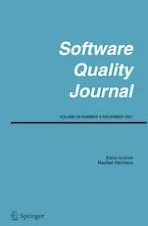
SQJ - volume 25 - 2017 论文列表 |
| 点击这里查看 Software Quality Journal 的JCR分区、影响因子等信息 |
Volume 25, Number 4, December 2017
Emelie Engström Kai Petersen Nauman Bin Ali Elizabeth Bjarnason
Onboarding inexperienced developers: struggles and perceptions regarding automated testing.Raphael Pham Stephan Kiesling Leif Singer Kurt Schneider
Test case selection in industry: an analysis of issues related to static approaches.Vincent Blondeau Anne Etien Nicolas Anquetil Sylvain Cresson Pascal Croisy Stéphane Ducasse
Model-based testing of digital TVs: an industry-as-laboratory approach.Hasan Sözer Ceren Sahin Gebizli
Toward the characterization of software testing practices in South America: looking at Brazil and Uruguay.Arilo Claudio Dias-Neto Santiago Matalonga Martín Solari Gabriela Robiolo Guilherme Horta Travassos
Industry-academia collaborations in software testing: experience and success stories from Canada and Turkey.Vahid Garousi Matt M. Eskandar Kadir Herkiloglu
Special issue on collaboration in software testing between industry and academia. In this issue.Volume 25, Number 3, September 2017
Aitor Arrieta Goiuria Sagardui Leire Etxeberria Justyna Zander
APOGEN: automatic page object generator for web testing.Andrea Stocco Maurizio Leotta Filippo Ricca Paolo Tonella
Automated refinement of models for model-based testing using exploratory testing.Ceren Sahin Gebizli Hasan Sözer
An empirical study on the effects of code visibility on program testability.Lei Ma Cheng Zhang Bing Yu Hiroyuki Sato
A large-scale study of call graph-based impact prediction using mutation testing.Vincenzo Musco Martin Monperrus Philippe Preux
Does choice of mutation tool matter?Rahul Gopinath Iftekhar Ahmed Mohammad Amin Alipour Carlos Jensen Alex Groce
Application of metamorphic testing monitored by test adequacy in a Monte Carlo simulation program. Separating passing and failing test executions by clustering anomalies. The central role of test automation in software quality assurance.Leonardo Mariani Dan Hao Rajesh Subramanyan Hong Zhu
Quality characteristics and measures for human-computer interaction evaluation in ubiquitous systems.Rainara M. Carvalho Rossana Maria de Castro Andrade Káthia Marçal de Oliveira Ismayle de Sousa Santos Carla Ilane Moreira Bezerra
State-based models in regression test suite prioritization.Luay Tahat Bogdan Korel George Koutsogiannakis Nada Almasri
A model-based framework encompassing a complete workflow from specification until validation of timing requirements in embedded software systems.Arne Noyer Padma Iyenghar Joachim Engelhardt Elke Pulvermüller Gert Bikker
Investigating the relation between lexical smells and change- and fault-proneness: an empirical study.Latifa Guerrouj Zeinab Azadeh Kermansaravi Venera Arnaoudova Benjamin C. M. Fung Foutse Khomh Giuliano Antoniol Yann-Gaël Guéhéneuc
Toward automatically quantifying the impact of a change in systems. In this issue.Volume 25, Number 2, June 2017
Sudhaman Parthasarathy Srinarayan Sharma
Availability analysis of software architecture decomposition alternatives for local recovery.Hasan Sözer Mariëlle Stoelinga Hichem Boudali Mehmet Aksit
Multi-objective code-smells detection using good and bad design examples.Usman Mansoor Marouane Kessentini Bruce R. Maxim Kalyanmoy Deb
Quantitative risk analysis of safety-critical embedded systems.Yinling Liu Guohua Shen Zhiqiu Huang Zhibin Yang
Multi-view refactoring of class and activity diagrams using a multi-objective evolutionary algorithm.Usman Mansoor Marouane Kessentini Manuel Wimmer Kalyanmoy Deb
Analysis of service diagnosis improvement through increased monitoring granularity.Cuiting Chen Hans-Gerhard Gross Andy Zaidman
Testing of model-driven development applications.Beatriz Marín Carlos Gallardo Diego Quiroga Giovanni Giachetti Estefanía Serral
H-Switch Cover: a new test criterion to generate test case from finite state machines.Érica Ferreira de Souza Valdivino Alexandre de Santiago Júnior Nandamudi Lankalapalli Vijaykumar
Test-Driven Development in scientific software: a survey. In this issue.Volume 25, Number 1, March 2017
Naveen Kulkarni Vasudeva Varma
A systematic literature review on the applications of Bayesian networks to predict software quality.Ayse Tosun Ayse Basar Bener Shirin Akbarinasaji
A transfer cost-sensitive boosting approach for cross-project defect prediction.Duksan Ryu Jong-In Jang Jongmoon Baik
Special section on realizing artificial intelligence synergies in software engineering. A declarative framework for stateful analysis of execution traces.Florian Wininger Naser Ezzati-Jivan Michel R. Dagenais
Fault localization for automated program repair: effectiveness, performance, repair correctness.Fatmah Yousef Assiri James M. Bieman
Effective software fault localization using predicted execution results.Ruizhi Gao W. Eric Wong Zhenyu Chen Yabin Wang
Reproducing failures based on semiformal failure scenario descriptions. Studying the advancement in debugging practice of professional software developers.Michael Perscheid Benjamin Siegmund Marcel Taeumel Robert Hirschfeld
10 Years of research on debugging concurrent and multicore software: a systematic mapping study.Sara Abbaspour Asadollah Daniel Sundmark Sigrid Eldh Hans Hansson Wasif Afzal
Efficient and scalable omniscient debugging for model transformations. Special issue on program debugging. In this issue.
